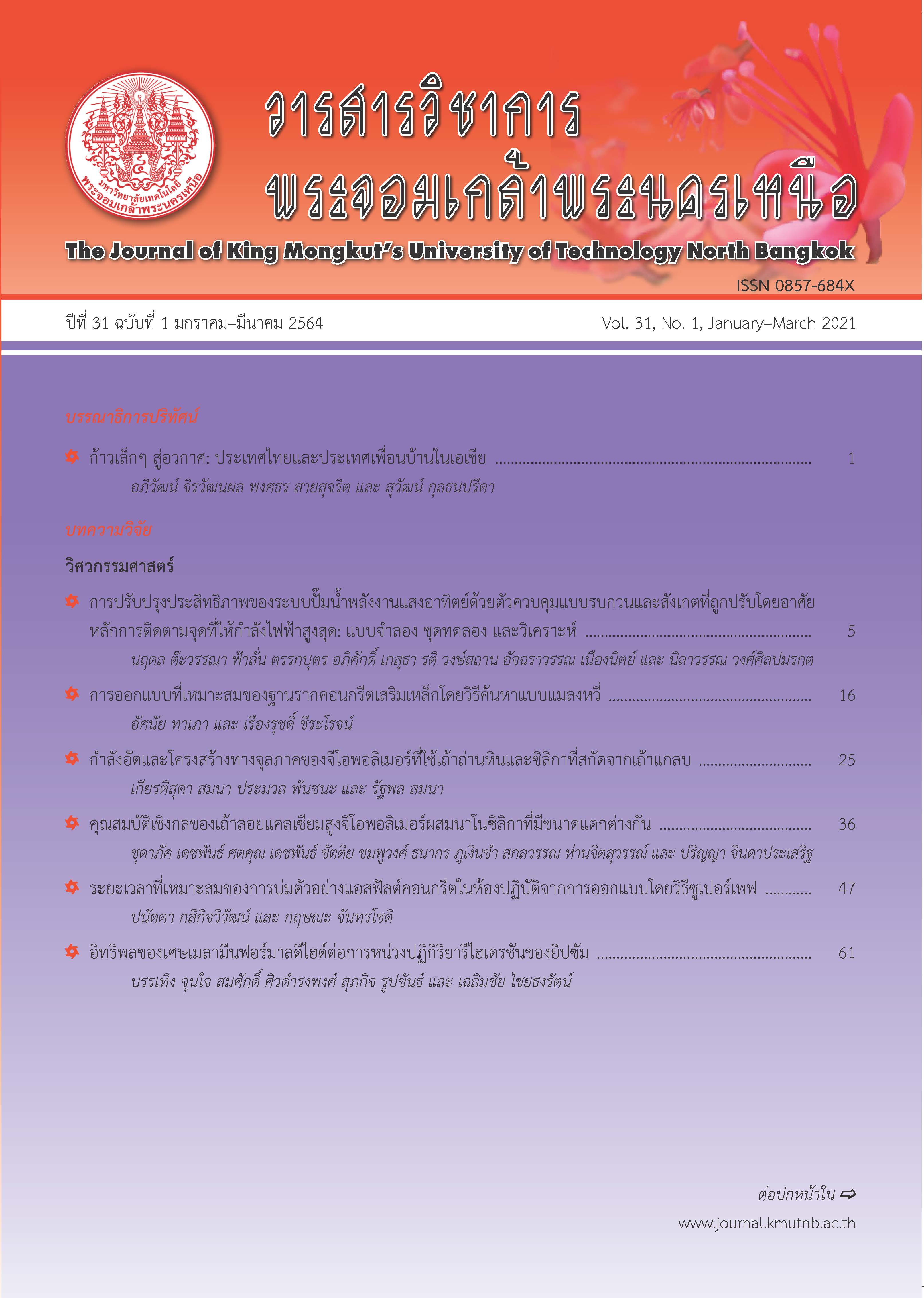การปรับปรุงประสิทธิภาพของระบบปั๊มน้ำพลังงานแสงอาทิตย์ด้วยตัวควบคุมแบบรบกวนและสังเกตที่ถูกปรับโดยอาศัยหลักการติดตามจุดที่ให้กำลังไฟฟ้าสูงสุด: แบบจำลอง ชุดทดลองและวิเคราะห์
Main Article Content
บทคัดย่อ
งานวิจัยนี้ได้สร้างแบบจำลองและชุดทดลองอย่างง่ายเพื่อทดสอบประสิทธิภาพของระบบปั๊มน้ำพลังงานแสงอาทิตย์ (Photovoltaic Water Pumping System; PVWPS) ขนาดเล็กที่ไม่ใช้แบตเตอรี่ โดยใช้ตัวควบคุมแบบการรบกวนและสังเกตที่ถูกปรับ (Modified Perturb and Observe Controller; MP&O) ซึ่งไม่ซับซ้อน และอาศัยหลักการติดตามจุดที่ให้กำลังไฟฟ้าสูงสุด (Maximum Power Point Tracking Method; MPPT) เพื่อเพิ่มประสิทธิภาพการแปลงพลังงานของระบบ (Energy Conversion Efficiency) ซึ่งเป็นอุปสรรคสำคัญในการประยุกต์ใช้เทคโนโลยีพลังงานแสงอาทิตย์สำหรับระบบไฟฟ้ากำลังตัวควบคุมที่นำเสนอจะสร้างสัญญาณควบคุมที่มีขนาดขั้นการควบคุมไม่คงที่ให้กับวงจรบัคคอนเวอร์เตอร์ (Buck Converter) เพื่อเลื่อนจุดทำงานไปยังจุดที่ให้กำลังไฟฟ้าสูงสุดของเซลล์แสงอาทิตย์ซึ่งจะถูกส่งผ่านไปยังโหลดคือมอเตอร์และปั๊มน้ำ ระบบ PVWPS-MPPT-MP&O ถูกจำลองโดยใช้โปรแกรม Matlab/Simulink และทวนสอบผลที่ได้จากแบบจำลองด้วยชุดทดลองต้นแบบระบบปั้มน้ำพลังงานแสงอาทิตย์ขนาด 130 วัตต์ ที่ถูกควบคุมผ่านไมโครคอนโทรลเลอร์แบบ Arduino ภายใต้สภาวะจริงของความเข้มแสงอาทิตย์และอุณหภูมิของแผงเซลล์ที่เปลี่ยนแปลงตลอดวัน ผลการทดสอบพบว่า ตัวควบคุมที่นำเสนอช่วยเพิ่มประสิทธิภาพการใช้พลังงาน (Energy Utilization Efficiency) และประสิทธิภาพของเซลล์แสงอาทิตย์ (PV Efficiency) ถึง 75.7 เปอร์เซ็นต์ และ 11.8 เปอร์เซ็นต์ ตามลำดับ ทำให้ประสิทธิภาพรวมของ PVWPS เพิ่มขึ้น 41 เปอร์เซ็นต์ เทียบกับ PVWPS ที่ไม่ใช้ตัวควบคุม
Article Details
บทความที่ลงตีพิมพ์เป็นข้อคิดเห็นของผู้เขียนเท่านั้น
ผู้เขียนจะต้องเป็นผู้รับผิดชอบต่อผลทางกฎหมายใดๆ ที่อาจเกิดขึ้นจากบทความนั้น
เอกสารอ้างอิง
[2] D. A. Karim and M. M. Marwan, “Solar powered induction motor-driven water pump operating on a desert well, simulation and field tests,” Renewable Energy, vol. 30, pp. 701–714, 2005.
[3] I. Seedadan, R. Wongsathan, and A. Nuangnit, “Modeling and simulation of a standalone PV solar-powered water pumping system,” presented at the 41st Electrical Engineering Conference (EECon-41), Ubol Ratchathani, Thailand, 2018 (in Thai).
[4] A. Ksentini, E. Azzag, and A. Bensalem, “Sizing and optimization of a photovoltaic pumping system,” International Journal of Energy Technology and Policy, vol. 15, no. 1, pp. 71–85, 2019.
[5] M. Habiballahi, M. Ameri, and S. H. Mansouri, “Efficiency improvement of photovoltaic water pumping system by means of water flow beneath photovoltaic cells surface,” Journal of Solar Energy Engineering, vol. 137, no. 4, pp. 1–8, 2015.
[6] T. Anuradha, V. S. Kumar, and P. S. Kumar, “A comparison of existing MPPT techniques for a PV system with interleaved converter,” Australian Journal of Basic and Applied Sciences, vol. 10, no. 5, pp. 69–75, 2016.
[7] F. Liu, Y. Kang, Y. Zhang, and S. Duan “Comparison of P&O and hill climbing MPPT methods for grid-connected PV converter,” presented at the 3rd IEEE Conference on Industrial Electronics and Applications, Singapore, 2018.
[8] R. Wongsathan and A. Nuangnit, “Optimal hybrid neuro-fuzzy based controller using MOGA for photo-voltaic (PV) battery charging system,” International Journal of Control Automation and Systems, vol. 16, no. 6, pp. 3036–3046, 2018.
[9] M. Kamran, M. Mudassar, M. R. Fazal, M. U. Asghar, M. Bilal, and R. Asghar “Implementation of improved Perturb & Observe MPPT technique with confined search space for standalone photovoltaic system,” Journal of King Saud University - Engineering Sciences, 2018.
[10] R. Gammoudi, H. Brahmi, and O. Hasnaoui, “Developed and STM implementation of modified P&O MPPT technique for a PV system over sun,” EPE Journal, vol. 29, no. 3, pp. 99–119, 2018.
[11] B. Tan, X. Ke, D. Tang, and S. Yin, “Improved perturb and observation method based on support vector regression,” Energies, vol. 12, no. 6, pp. 1–11, 2019.
[12] R. Wongsathan and I. Seedadan, “Artificial intelligence and ANFIS reduced rule for equivalent parameter estimation of PV module on various weather conditions utilized for MPPT,” Journal of Renewable Energy and Smart Grid Technology, vol. 12, no. 1, pp. 38–55, 2007 (in Thai).

